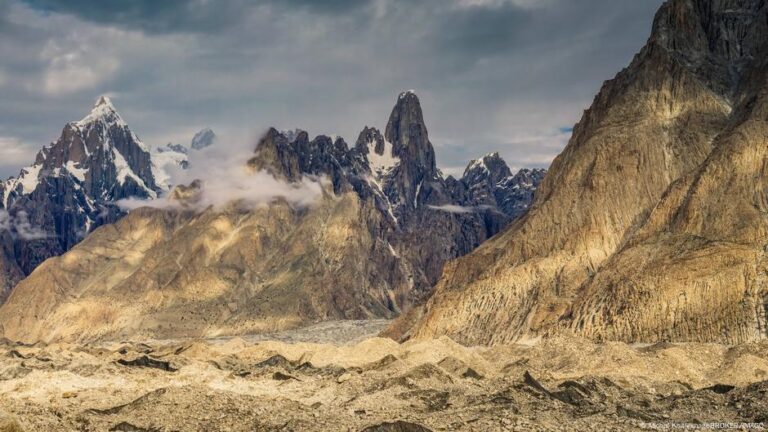Could mountaineer Laura Dahlmeier still be alive if it weren’t for climate change? Of course, any answer to this is speculative. But it cannot be denied that ever-increasing temperatures have also taken their toll on the mountain in Pakistan where the former German biathlon star had her fatal accident. Falling rocks, such as those that caused Dahlmeier’s death, are becoming increasingly common on the mountains in the region.
The 6,096 meter (20,000 feet) high Laila Peak in the Karakoram is an eye-catcher. Its shape is reminiscent of a shark’s tooth jutting into the sky. The mountain is steep on all sides and challenging from a mountaineering point of view. When the author of this article passed this mountain 20 years ago, its north-west face was still covered in a thick layer of snow.
This attracted not only mountaineers, but also extreme skiers who tried their hand at descending this steep face. Now though, there is only a thin layer of snow in some places on this mountain flank, while large areas are now bare rock.
Before this year’s climbing season, which began in July, the usual precipitation had failed to materialize. In addition, very high temperatures accelerated the melting of the snow. In the small town of Chilas, located at 1265 meters above sea level on the southern edge of the Karakoram, the thermometer rose to a record 48.5 degrees Celsius (119 Farenheit) in July.
Up to altitudes of over 5,500 meters, it rained instead of snowing, and there was not even a night frost in some places. Mountaineers reported unusually warm and dry conditions on the country’s mountains up to over 8,000 meters.
Snow and ice are normally a kind of natural glue that ensures that boulders stay in place. If the snow melts, the risk of rockfall and wet snow avalanches increases. Some expeditions left the Karakoram prematurely this summer without reaching the summit. The verdict: too dangerous.
Expeditions must change their schedules
“I believe that in future, expeditions will have to get to Pakistan earlier – because of climate change, which is very clearly noticeable there,” says experienced German mountaineer David Göttler. “I think that’s inevitable.”
Göttler climbed the 8,125-metre-high Nanga Parbat at the end of June – in alpine style, i.e. without bottled oxygen, permanently installed ropes, fixed high camps or the support of sherpas. Together with his two team mates from France, he had previously acclimatized to the thin air on a six-thousander and a seven-thousander in Nepal.
“It’s crazy how quickly these mountains are changing,” Göttler said. “The objective dangers are increasing, and rockfall is on the rise.”
One example is the 7,162-meter-high Baruntse, not far from Mount Everest.
“Huge crevasses open up on the summit ridge, and you have to find your way around them. It wasn’t a very challenging mountain in the past,” Göttler added. “But now, even as a beginner, you really have to know what you are doing with your crampons on a seven-thousander like this.”
To avoid the threat of rockfall in the warm midday hours, climbers have started to set off earlier and earlier. On particularly vulnerable mountains, climbers have turned to climbing at night and resting during the day.
Heavy rainfall, dam collapses at glacial lakes
Extreme weather events caused by climate change are also increasing on the highest mountains. In the Karakoram, several concrete bridges over rivers were literally washed away after heavy rainfall a week and a half ago. This meant that expeditions had to take alternate routes on their arrival and departure. At least 18 people died.
In Nepal, floodwaters destroyed a bridge over a border river to Tibet in July. More than 20 people lost their lives. The flooding was triggered by heavy monsoon rains, aggravated by a glacial lake flood.
Due to increasing glacial melt, large lakes have been forming below natural dams. If these dams break, water masses flow downhill. The number of such so-called GLOFs (Glacial Lake Outburst Floods) has been rising rapidly in the Himalayas and Karakoram, according to the International Centre for Integrated Mountain Development (ICIMOD) in Nepal.
Economic dependence on mountain tourism
There are fears that over the medium term, the increasing dangers – and the associated declining chances of reaching a summit – could lead to a decline in interest in commercial expeditions. For regions like the Mount Everest area in Nepal or many small towns and villages in northern Pakistan, this would be an economic catastrophe.
Most people there are dependent upon mountain tourism for their livelihoods. If the climbers stay away, not only will the local mountain guides and porters lose their jobs, but lodge owners will have no more guests, and innkeepers and traders will lose their customers as well.
This is a key reason why Nepal and Pakistan have repeatedly sounded the alarm about the dangers of global climate change – and continue to urge industrialized countries to take action to combat it.
So far, their pleas have gone largely go unheeded – just like that of United Nations Secretary-General Antonio Guterres.
“Nepal has lost close to one third of its ice in just over 30 years. Antarctica and Greenland are losing billions of tons of ice mass every year,” Guterres said during a 2023 visit to the Everest region in Nepal.
“Melting glaciers means swollen lakes and rivers flooding, sweeping away entire communities.
“I’m here to cry out from the rooftop of the world, stop the madness!”
This article was originally written in German.


